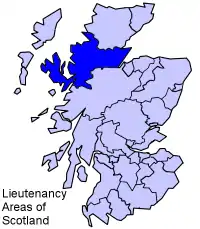
lieutenancy area (1996–present)
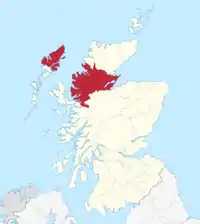
county (1889–1975)
Ross and Cromarty (Scottish Gaelic: Ros agus Cromba), also referred to as Ross-shire and Cromartyshire, is a variously defined area in the Highlands and Islands of Scotland. There is a registration county and a lieutenancy area in current use, the latter of which is 8,019 square kilometres (3,096 square miles) in extent. Historically there has also been a constituency of the Parliament of the United Kingdom (1832 to 1983), a local government county (1890 to 1975), a district of the Highland local government region (1975 to 1996) and a management area of the Highland Council (1996 to 2007). The local government county is now divided between two local government areas: the Highland area and Na h-Eileanan Siar (the Western Isles). Ross and Cromarty border Sutherland to the north and Inverness-shire to the south.
The county was formed by the uniting of the shires of Ross-shire and Cromartyshire. Both these shires had themselves been formed from the historic province of Ross, out of which the many enclaves and exclaves that formed Cromartyshire were carved out, leaving the remaining area to become Ross-shire.[1] These parcels of land were for many purposes administered as part of Ross-shire rather than Cromartyshire.[1][2][3] The county also included the Isle of Lewis, however this is not part of the modern lieutenancy area (which instead includes the Isle of Skye), although Lewis is part of the current registration county.
Geography

Western Ross and Cromarty, also known as Wester Ross, is typified by its mountainous Highland scenery, especially the Torridon Hills which includes such peaks as Beinn Eighe and Liathach. The highest point in the county is Càrn Eighe at 1,183 metres (3,881 feet). It contains a long, fractured coastline along The Minch and Inner Sound (opposite Skye), consisting of a number of isolated peninsulas split by sea lochs; from north to south the chief of these are Coigach, Loch Broom, the Scoraig peninsula, Little Loch Broom, Gruinard Bay, Rubha Mòr peninsula, Loch Ewe, Rua Reidh/Melvaig peninsula, Loch Gairloch, Loch Torridon, Applecross peninsula, Loch Kishorn, Loch Carron, Lochalsh peninsula, Loch Long, Loch Duich and the Glenelg peninsula which is shared with Inverness-shire.
The eastern half (Easter Ross) is generally flatter, and consists of towns, villages and farmland bordering the Moray Firth. In the north Dornoch Firth separates the county from Sutherland; near the Dornoch Firth Bridge lies the thin, tapering Ness of Portnaculter peninsula. In the north-east can be found the hammerhead-shaped Tarbat peninsula; across Cromarty Firth lies the Black Isle (actually a peninsula not an island). To the south-east Beauly Firth forms the border with Inverness-shire.
The county contains numerous lochs, the most prominent of these being Loch Ailsh, Crom Loch, Loch a' Choire Mhòir, Loch Fada, Lochan Gaineamhaich, Loch Cluanie, Loch Loyne, Loch Monar, Loch Mullardoch, Loch a' Bhealaich, Loch nan Eun, Loch na Leitreach, Loch an Laoigh, Loch Calavie, An Gead Loch, Loch an Tachdaidh, Loch Sgamhain, Loch a' Chroisg, Loch Clair, Loch Coulin, Loch Fhiarlaid, Loch Dughaill, Loch Coultrie, Loch Damph, Loch Lundie, Loch na A-Oidhche, Loch Maree, Loch a' Ghodhainn, Loch Ghaineamhach, Loch Bad an Sgalaig, Loch a' Bhraoin, Loch Fannich, Fionn Loch, Loch na Sealga, Loch Eye, Loch Glass, Loch Morie, Loch Ussie, Loch Achilty, Loch Garve, Loch Luichart, Loch Achanalt, Loch Meig, Loch Droma, Loch Glascarnoch, Loch Coire Làir, Loch Vaich, Loch a' Chaorunn, Loch na Caoidhe, Loch Beannacharain, Loch na Totaig, Loch Osgaig, Loch Raa, Loch Vatachan, Fionn Loch, Loch Veyatie, Loch Lurgainn, Loch Bad a' Ghaill, Loch Sionascaig, Lochan Tuath, Loch an Doire Duibh, Loch Doire na h-Airbhe, Loch a Ghille, Loch Buine Mhòire, Loch Call an Uidhean, Loch a' Chroisg, Loch Achall, Loch an Daimh, Loch na Maoile, Loch Ob an Lochain, Clar Lochan, Loch an Eilein and the Orrin Reservoir.
Lewis is the northern part of Lewis and Harris, the largest island of the Outer Hebrides and the third largest in the British Isles after Britain and Ireland. Due to its flatter, more fertile land, Lewis contains three-quarters of the population of the Western Isles, and the largest settlement, Stornoway. To the west lie the isolated and uninhabited Flannan Isles. About 44 miles (71 kilometres) north of the Butt of Lewis lie North Rona and Sula Sgeir, a remote group of islands which are included within Ross-shire.
Islands
Mainland
- A' Ghlas-Leac
- An Garbh-Eilean
- Black Islands
- Crowlin Islands
- Eilean a' Chait
- Eilean a' Mhal
- Eilean an Inbhire Bhàin
- Eilean an t-Sratha
- Eilean Bàn
- Eilean Chuaig
- Eilean Dubh Dhurinis
- Eilean Furadh Mòr
- Eilean Horrisdale
- Eilean Mòineseach
- Eilean Mòr
- Eilean na Bà
- Eilean na Bà Mòr
- Eilean na Beinne
- Eilean na Creige Duibhe
- Eilean nam Feannag
- Eilean nan Naomh
- Eilean Stacan
- Eilean Tioram
- Eileanan Dubha
- Fraoch Eilean
- Fraoch Eilean Mòr
- Fraoachlan
- Glas Eilean
- Green Island
- Gruinard Island
- Isle of Ewe
- Kishorn Island
- Làrach Tigh Mhic Dhomhnuill
- Longa Island
- Sgeir a' Bhuic
- Sgeir a' Ghair
- Sgeir an Araig
- Sgeir an Fheòir
- Sgeir Bhuide
- Sgeir Bhuidhe
- Sgeir Chreagach
- Sgeir Dùghaill
- Sgeir Fhada
- Sgeir Ghlas
- Sgeir Maol Mhoraidh
- Sgeir Maol Mhoraidh Shuas
- Sgeir Mhòr
- Sgeir na Trian
- Shieldaig Island
- Strome Islands
- Summer Isles
- Ulluva
Lewis
- Àird Orasaigh
- Bearasaigh
- Bhuaile Mhòr
- Bràighe Mòr
- Bratanais Mòr
- Campaigh
- Ceabagh
- Ceabhaigh
- Cealasaigh
- Cliatasaigh
- Craigeam
- Cruitear
- Cùl Campaigh
- Eilean a' Bhlàir
- Eilean an Tighe
- Eilean Àrnol
- Eilean Beag a' Bhàigh
- Eilean Bhàcasaigh
- Eilean Bhinndealaim
- Eilean Chearstaigh
- Eilean Chalaibrigh
- Eilean Chaluim Cille
- Eilean Cheòis
- Eilean Dubh a' Bhàigh
- Eilean Fir Chrothair
- Eilean Liubhaird
- Eilean Mhealasta
- Eilean Molach
- Eilean Mòr a' Bhàigh
- Eilean Mòr Lacasaidh
- Eilean Mòr Phabail
- Eilean nan Uan
- Eilean Orasaidh
- Eilean Orasaigh
- Eilean Rosaidh
- Eilean Sgarastaigh
- Eilean Shìophoirt
- Eilean Teinis
- Eilean Thinngartsaigh
- Eilean Thòraidh
- Eilean Thuilm
- Eilean Trosdam
- Eughlam
- Eunaigh Mòr
- Flannan Isles
- Fleisgeir
- Flodaigh, Lewis
- Flodaigh (Outer Loch Ròg)
- Fuaigh Beag
- Fuaigh Mòr
- Garbh Eilean
- Geile Sgeir
- Glas Sgeir
- Gousam
- Great Bernera
- Grèineam
- Hairsgeir Beag
- Hairsgeir Mòr
- Lada Sgeir
- Langaisgeir Mòr
- Lewis (part of the larger Lewis and Harris island)
- Linngeam
- Liongam
- Lìth Sgeir
- Little Bernera
- Màs Sgeir
- Pabaigh Beag
- Pabaigh Mòr
- Riosaigh
- Seanna Chnoc
- Sgeir a' Mhurain
- Sgeir Dhail
- Sgeir Dhearg
- Sgeir Ghlas Bheag
- Sgeir Ghobhlach
- Sgeir Leathann
- Sgeir Liath
- Sgeir Mhòr Shildinis
- Sgeir Mol Srupair
- Sgeir Sgianailt
- Sgeir Tanais
- Sgeirean An Arbhair
- Shiant Islands
- Siaram Bostadh
- Siaram Mòr
- Tabhaigh Bheag
- Tabhaigh Mhòr
- Tamna
- Tanaraigh
- Tannaraidh
- Thalta Sgeir
- Vacsay (Bhàcasaigh in Gaelic)
North Rona
- Ghealldraig Mhòr
- Gralisgeir
- Lisgear Mhòr
- North Rona
- Sula Sgeir
- Thamna Sgeir
 Eilean Bàn from the Skye Bridge, looking towards Kyle of Lochalsh
Eilean Bàn from the Skye Bridge, looking towards Kyle of Lochalsh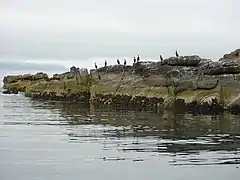 Shag birds on Longa Island
Shag birds on Longa Island The Isle of Ewe
The Isle of Ewe Cave on Garbh Eilean, Shiant Isles
Cave on Garbh Eilean, Shiant Isles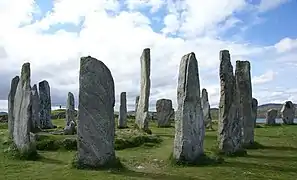 The famous Callanish Stones on Lewis
The famous Callanish Stones on Lewis Seana Chnoc (at left) and Bearasaigh from the south west. Stac nam Balg is just visible to the left of Seanna Chnoc
Seana Chnoc (at left) and Bearasaigh from the south west. Stac nam Balg is just visible to the left of Seanna Chnoc
Economy and population
The main economic activities in Ross and Cromarty are crofting, fishing and tourism. The population as of 2001 was 49,967.[4]
Parliamentary constituency
The name Ross and Cromarty was first used for the Ross and Cromarty county constituency of the Parliament of the United Kingdom from 1832 to 1983. As created in 1832, the constituency merged two former county constituencies: the Ross-shire constituency and the Cromartyshire constituency, and it elected a Member of Parliament to represent the counties of Ross-shire and Cromartyshire, minus their parliamentary burghs, Dingwall, Tain and Fortrose, which were represented as components of the Wick burghs constituency and the Inverness burghs constituency.
Constituency boundaries were altered in 1918, by the Representation of the People Act 1918, and the Ross and Cromarty constituency acquired the boundaries of the county of Ross and Cromarty, including the former parliamentary burghs, but minus Stornoway and Lewis, which became part of a new constituency, the Western Isles constituency.
In 1983, the Ross, Cromarty and Skye constituency was created to represent the then Ross and Cromarty district and Skye and Lochalsh district. The Kincardine area joined the Caithness and Sutherland constituency.
Local government
County
.jpg.webp)
The local government county of Ross and Cromarty was created in 1890 under the Local Government (Scotland) Act 1889, with boundaries similar to, but not exactly the same as, the boundaries of the constituency. Ross and Cromarty County Council was based at County Buildings in Dingwall.[5]
The county continued with largely unchanged boundaries until its abolition in 1975. When the county was abolished in 1975, the mainland part became part of the new Highland region, and Lewis became part of the Western Isles islands area.
District
In 1975 the mainland part of the former county was effectively divided between three districts of the Highland region. Most of the former county became the new district of Ross and Cromarty. The Lochalsh area joined the Skye and Lochalsh district and the Kincardine area joined the Sutherland district. The district was abolished in 1996.
Since 1996
The wards in the former district of Ross and Cromarty formed the management area of Ross and Cromarty from 1996 to 1999, and again from 1999 to 2007. The name was not used for a management area after 2007, although some local decisions are delegated to the Ross and Cromarty area committee, which consists of all Highland councillors representing Ross and Cromarty.[6][7]
Civil parishes
In the medieval period the area was divided into the following civil and ecclesiastical parishes:
- Alness
- Avoch
- Barvas (on the Isle of Lewis)
- Contin
- Cromarty
- Cullicudden
- Dingwall or Inverferan
- Edderton
- Fearn
- Fodderty
- Gairloch
- Kilchrist or Tarradale
- Killearnan aka Ederdour
- Kilmuir Easter
- Kilmuir Wester
- Kiltearn
- Kincardine
- Kinnettes
- Kintail
- Kirkmichael
- Lemlair
- Lochalsh
- Lochbroom
- Lochcarron
- Lochs (on the Isle of Lewis)
- Logie Easter
- Logie Wester or Logiebride
- Nigg
- Nonakiln
- Rosemarkie
- Rosskeen
- Stornoway or Eye (on the Isle of Lewis)
- Suddy
- Tain
- Tarbat
- Uig (on the Isle of Lewis)
- Urquhart
- Urray
Changes took place in the post-Reformation period. The parish of Applecross was created in 1726 out of part of the parish of Lochcarron.[8] The parishes of Kilmuir Wester and Suddy were united in 1750 to form the parish of Knockbain. The parishes of Urquhart and Logie Wester were united in 1845. The parish of Glenshiel was created out of part of Kintail c. 1750.[9]
Kilchrist was absorbed into Urray in 1574.[10]
Lemlair was absorbed into Kiltearn in 1618.[11] Nonakiln was absorbed into Rosskeen c. 1714.[12] Kinnettes was absorbed into Fodderty c. C16th.[13] The parishes of Cullicudden and Kirkmichael were united c. 1700 to form the parish of Resolis.[14]
Registration county
The registration county of Ross and Cromarty, used for land registry purposes, covers the area of the former county of Ross and Cromarty, including Lewis.[15]
Lieutenancy area
Lieutenancy areas are subdivisions used for the ceremonial lord lieutenants, the monarch's representatives. The Ross and Cromarty lieutenancy area combines the areas of two former districts of the Highland region: Ross and Cromarty, and Skye and Lochalsh. The area therefore includes the mainland part of the registration county and former administrative county of Ross and Cromarty, excluding Kincardine, with the addition of the Isle of Skye, which is in the registration county (and former administrative county) of Inverness-shire.
Transport
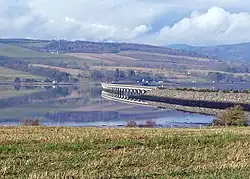
The Kyle of Lochalsh railway line traverses the county west–east, terminating at Inverness. The Far North Line goes north–south along the east coast, connecting Inverness in the south with Thurso and Wick in the north.
The Black Isle is connected by bridge to the 'mainland' - Cromarty Bridge in the north-west and the Kessock Bridge in the south-west. At the tip of the peninsula a ferry provides access to the Tarbat peninsula. The Skye Bridge links Kyle of Lochalsh to the isle of Skye.
Various buses operated by Stagecoach Group link the major towns of the east coast, with the 61 bus connecting Ullapool to Inverness.[16] The latter route is also served by Scottish Citylink in the summer, continuing on to Glasgow.[17] Various independent bus companies link the smaller towns of Wester Ross, though online information is limited.
A ferry connects Stornoway on Lewis with Ullapool on the mainland, taking about three hours.
The county contains one airport - Stornoway - which provides passenger flights to destinations within Scotland as well as London Southend.
Settlements
Mainland


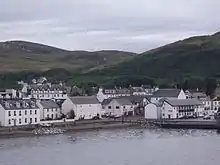
- Achnasheen
- Achiltibuie
- Alness
- Altandhu
- Applecross
- Ardgay
- Aultbea
- Avoch
- Badenscallie
- Balintore
- Barbaraville
- Conon Bridge
- Contin
- Cromarty
- Culbokie
- Culrain
- Diabaig
- Dingwall
- Dornie
- Dundonnell
- Edderton
- Evanton
- Fearn
- Fortrose
- Garve
- Gairloch
- Hill of Fearn
- Inver
- Invergordon
- Inverinate
- Inverness
- Jemimaville
- Kildary
- Kilmuir, Black Isle
- Kilmuir, Easter Ross
- Kinlochewe
- Kyle of Lochalsh
- Laide
- Lochcarron
- Marybank
- Maryburgh
- Milton
- Muir of Ord
- Mulbuie
- Munlochy
- Nigg
- North Kessock
- Polbain
- Polglass
- Poolewe
- Portmahomack
- Reraig
- Rieff
- Rosemarkie
- Shieldaig
- Strathcarron
- Strathpeffer
- Stromeferry
- Tain
- Torridon
- Ullapool
Isle of Lewis

- Achmore
- Adabrock
- Aignish
- Aird
- Aird Uig
- Airidhbhruaich
- Arnol
- Back
- Balallan
- Ballantrushal
- Barvas
- Borve
- Bragar
- Branahuie
- Brue
- Breaclete
- Breanish
- Breasclete
- Calbost
- Callanish
- Carishader
- Carloway
- Caverstay
- Cliff
- Coll
- Cromore
- Cross
- Crossbost
- Crowlista
- Dalbeg
- Eagleton
- Eorodale
- Eoropie
- Fivepenny
- Flesherin
- Garynahine
- Garyvard
- Geishader
- Gisla
- Gravir
- Gress
- Grimshader
- Habost
- Hacklete
- Holm
- Islivik
- Keose
- Keose Glebe
- Kershader
- Kirkibost
- Kneep
- Knockaird
- Laxay
- Laxdale
- Lemreway
- Leurbost
- Lionel
- Lower Bayble
- Mangursta
- Marvig
- Marybank
- Meavik
- Melbost
- Newmarket
- Newvalley
- North Dell
- North Galson
- North Tolsta
- Orinsay
- Parkend
- Plasterfield
- Portnaguran
- Port of Ness
- Portvoller
- Ranish
- Sandwick
- Shader
- Shawbost
- Sheshader
- Shieldenish
- Shulishader
- Skigersta
- South Dell
- South Galson
- Steinish
- Stornoway
- Swainbost
- Timsgarry
- Tobson
- Tong
- Upper Bayble
- Valtos
See also
References
- 1 2 Mackenzie 1810, pp.15–16
- ↑ Her Majesty’s Law Commissioners, Scotland (1839). "Appendix; Return by John Jardine, Esq., Sheriff of Ross and Cromarty". Fourth Report. Command papers. Vol. C 241. p. 186.
- ↑ Ordnance Gazetteer of Scotland, Vol.2 p.310–1, Cromartyshire
- ↑ "ROSS AND CROMARTY: The Area of Ross and Cromarty in Scotland". British-towns.net. 15 July 2017. Archived from the original on 16 September 2017. Retrieved 24 July 2017.
- ↑ "Public urged to attend Dingwall meeting". Ross-shire Journal. 28 October 2014. Retrieved 19 July 2021.
- ↑ "Ross and Cromarty Committee: Tasks and responsibilities". Highland Council. Retrieved 7 December 2018.
- ↑ "Ross and Cromarty Committee: Ward representation". Highland Council. Retrieved 7 December 2018.
- ↑ GENUKI. "Genuki: Applecross, Ross and Cromarty". www.genuki.org.uk. Retrieved 31 January 2021.
- ↑ GENUKI. "Genuki: Glensheil, Ross and Cromarty". www.genuki.org.uk. Retrieved 1 February 2021.
- ↑ "Saints in Scottish Place-Names - Tarradale, former parish, aka Kilchrist, Urray". saintsplaces.gla.ac.uk. Retrieved 1 February 2021.
- ↑ "Lemlair Parish". www.cushnieent.com. Retrieved 1 February 2021.
- ↑ "Nonakiln | Canmore". canmore.org.uk. Retrieved 1 February 2021.
- ↑ "Kinnettes Parish". www.cushnieent.com. Retrieved 1 February 2021.
- ↑ "History of Cullicudden, in Highland and Ross and Cromarty | Map and description". Archived from the original on 6 February 2021.
- ↑ "Map of Land Register counties" (PDF). Ros.gov.uk. Archived from the original (PDF) on 28 September 2013. Retrieved 24 July 2017.
- ↑ "Stagecoach North Scotland - Black Isle and Easter Ross Travel Guide from 07 January 2019" (PDF). Retrieved 23 June 2019.
- ↑ "Citylink Timetable - Glasgow to Ullpool" (PDF). Retrieved 23 June 2019.
Further reading
- D. Alston, Ross and Cromarty : a historical guide (Edinburgh : Birlinn, 1999 ISBN 1-874744-48-3), which, however, restricts itself to coverage of the mainland county;
- R. Bain, History of the Ancient Province of Ross (Dingwall, 1899);
- J. H. Dixon, Gairloch (Edinburgh, 1888);
- F. N. Reid, The Earls of Ross (Edinburgh, 1894);
- W. C. Mackenzie, History of the Outer Hebrides (Paisley, 1904).
